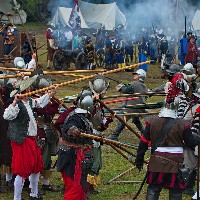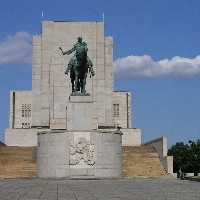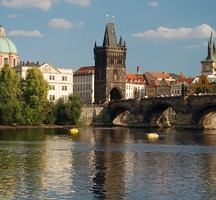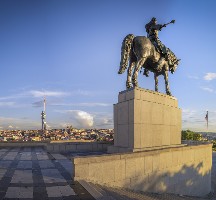Breadcrumbs navigation
Prague’s places of dramatic history
Famous battles, assassinations, the mysterious deaths of the Cold War, incendiary torches… The capital city of Prague has a long and chequered history. And it certainly has not been some kind of “idyll” – the Czech metropolis has had a whole host of past experience with many conflicts, some of which have been key milestones of European history. Let’s now look at some of the places linked to some ancient, as well as relatively recent dramatic events.
The Mirror Maze on Petřín Hill and the Old Town Bridge Tower
If you want to see Prague’s echoes of ancient history clanking with military arms, an interesting option is to go to Petřín and visit the mirror maze, at the end of which is a realistic diorama depicting the Battle for Charles Bridge. This is in memory of a real event – the final battle of the Thirty Years’ War, when Prague was besieged by the Swedish army of General Königsmarck in the year 1648, just before the Peace of Westphalia was signed. The Swedes had at that time managed to occupy Prague Castle and the Lesser Town, but their attempt to cross Charles Bridge was thwarted by Imperial soldiers helped by the townsfolk and students fighting alongside. The site where the toughest fighting took place was the Old Town Bridge Tower.
Bělohorská pláň (White Mountain plain)
The Thirty Years’ War not only ended in Prague, it began there. If you visit the Czech capital in the second half of September, do not miss the great re-enactment of the Battle of White Mountain that takes place annually on the plain by the wall that goes around the Hvězda deer park. Revisiting the distant past takes only a few minutes by tram from the City centre.
The Vítkov memorial
Medieval and modern history are distinctly interwoven atop Vítkov Hill. This is where, in 1420, one of the first major battles of the Hussite wars took place; at which the Hussites, led by the then still not entirely known though respected Hetman Jan Žižka of Trocnov managed to repel the attack of the Crusader army. For a time, the Hussites became the bane of Europe. Prague townspeople had been wanting to build a memorial statue to Jan Žižka of Trocnov on this commemorative site ever since the end of the nineteenth century. The project got the commensurate financial and political backing during the First Republic, the Memorial being built between 1929 and 1938. It is dominated by a bronze equestrian statue of Jan Žižka from a design by sculptor Bohumil Kafka. The sixteen tonne and nine metre high statue was long rumoured to be the largest of its kind in the world.
What does make the Vítkov Monument unique is its rich history. Originally, it was to serve as a kind of “Memorial of the First Republic”. The marble building was to be the burial place of prominent Legionnaires, and to hold key artefacts of modern Czech statehood. But the time for it to do so had run out. And so it was that it served first as a warehouse for the Wehrmacht, and later as the burial place of Communist Party notables. For “the first labourer-president”, Klement Gottwald, a kind of mausoleum was built, like that on Red Square in Moscow, and served its purpose until 1962. Today the Memorial comes under the National Museum, and offers a permanent exhibition: “The crossroads of Czech and Czechoslovak statehood”.
The Church of Sts Cyril and Methodius and the Petschke Palazzo
The crossroads of Czech and Czechoslovak statehood are to be seen elsewhere, too. One of the notable events is that of 27 May 1942, when the paratroopers Jan Kubiš and Josef Gabčík made their attempt to assassinate the then third highest ranking Nazi officer, Reinhard Heydrich, who was at that time the Deputy Reichsprotector in Prague, where he was conceptualising the euphemistic “final solution to the Czech question”. The bend in the road in Prague’s Libeň quarter, where Gabčík confronted Heydrich’s open-topped car with his sub-machine gun, is no longer there. In the 1970s it gave way to the construction of the Prosek radial dual carriageway.
The heroism of the paratroopers is, however, commemorated at the site of their last battle – in the Church of Sts Cyril and Methodius in Resslova street near Karlovo square. After the betrayal of seven paratroopers by their former comrade Karel Čurda some 800 members of the SS and the Gestapo were deployed to track them down. The final stand-off lasted more than two hours and took its toll on the besieging side. The window to the crypt of the church still bears witness to the hard-fought gunfight, showing the bullet holes from the assault rifles and the machine gun that had been placed on the rooftop opposite.
Many victims of the Heydrich attack retaliation drive ended their lives in the Petschke Palazzo near Wenceslas Square. This modern building, built at the end of the 1920s by the Jewish banker Julius Petchke was commandeered by the Gestapo in 1939, who set up their headquarters there. It also had a torture chamber, and thousands of Czech patriots passed through its doors before the war was over.
An unparalleled exposition associated with the Heydrichiad is at the Army Museum in Žižkov. It includes some well preserved personal belongings of the London paratroopers.
Wenceslas Square
If there is one place in Prague which can unquestionably be called the “boulevard of history” it is Wenceslas Square. The number of major events that have taken place under the statue of St Wenceslas would fill a book. Let’s first take a look at two of them – the tragedies that marked the “Prague Spring” of 1968.
The first is the mysterious death of US diplomat Charles Jordan in the summer of 1967. Jordan, Director of the American Joint Distribution Committee, flew to Prague in August 1967 from Bucharest, supposedly on vacation. He booked into the luxury Hotel Esplanade near Wenceslas Square. On 19 July 1967 Jordan told his wife he was going to Wenceslas Square to buy some cigarettes. When he still had not come back after some considerable time, Mrs Jordan alerted the American Embassy and the police. Too late. Mr Jordan’s body was found a fortnight later in the Vltava River near Charles Bridge. Exactly what happened was a question the Czechoslovak public asked to no avail, and despite several investigations the case remains open to this day. The question which of the secret services were behind the Prague murder will probably remain unanswered. What we do know is that the death of Mr Jordan belonged to the list of goings-on that precipitated the dramatic developments in Czechoslovakia in 1967 and 1968, linked inextricably to the so-called “Prague Spring”.
Hopes were dashed, as we know, on 21 August 1968 and the “Prague Spring” earned its definitive full-stop a few months later. On sixteenth January 1969, Wenceslas Square witnessed the self-immolation of the Philosophy Faculty student Jan Palach, and on 25 February that year, of the Šumperk polytechnic student Jan Zajíc. Their action was the last futile gesture of resistance against the Soviet occupation. Palach and Zajíc have an original memorial and commemorative inscription on Wenceslas Square. The Grave of Jan Palach, decorated with a relief by the famous Czech sculptor Olbram Zoubek, is at Olšany cemetery. We still owe a dignified memorial to Mr Jordan and the other victims of the Cold War.
However, history continued its march along Wenceslas Square. In November 1989, it was one of the venues with the greatest demonstration against the ruling Communist regime. The Melantrich building, from whose balcony Václav Havel, Alexander Dubček, or Karel Kryl among others addressed the hundreds of thousands strong crowd is now a Marks & Spencer store. But the façade has not changed much – apart from bearing the famous multinational company logo. The atmosphere of the “Velvet Revolution” on Wenceslas Square is best felt just before Christmas, when people remember President Václav Havel by lighting candles around the St Wenceslas statue.
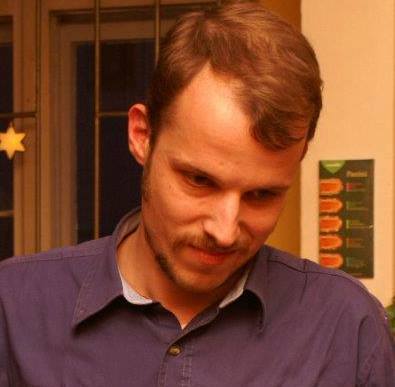 Lukáš Janata,
Lukáš Janata,
columnist, author, lover of Prague and its modern – but also more distant – history.

